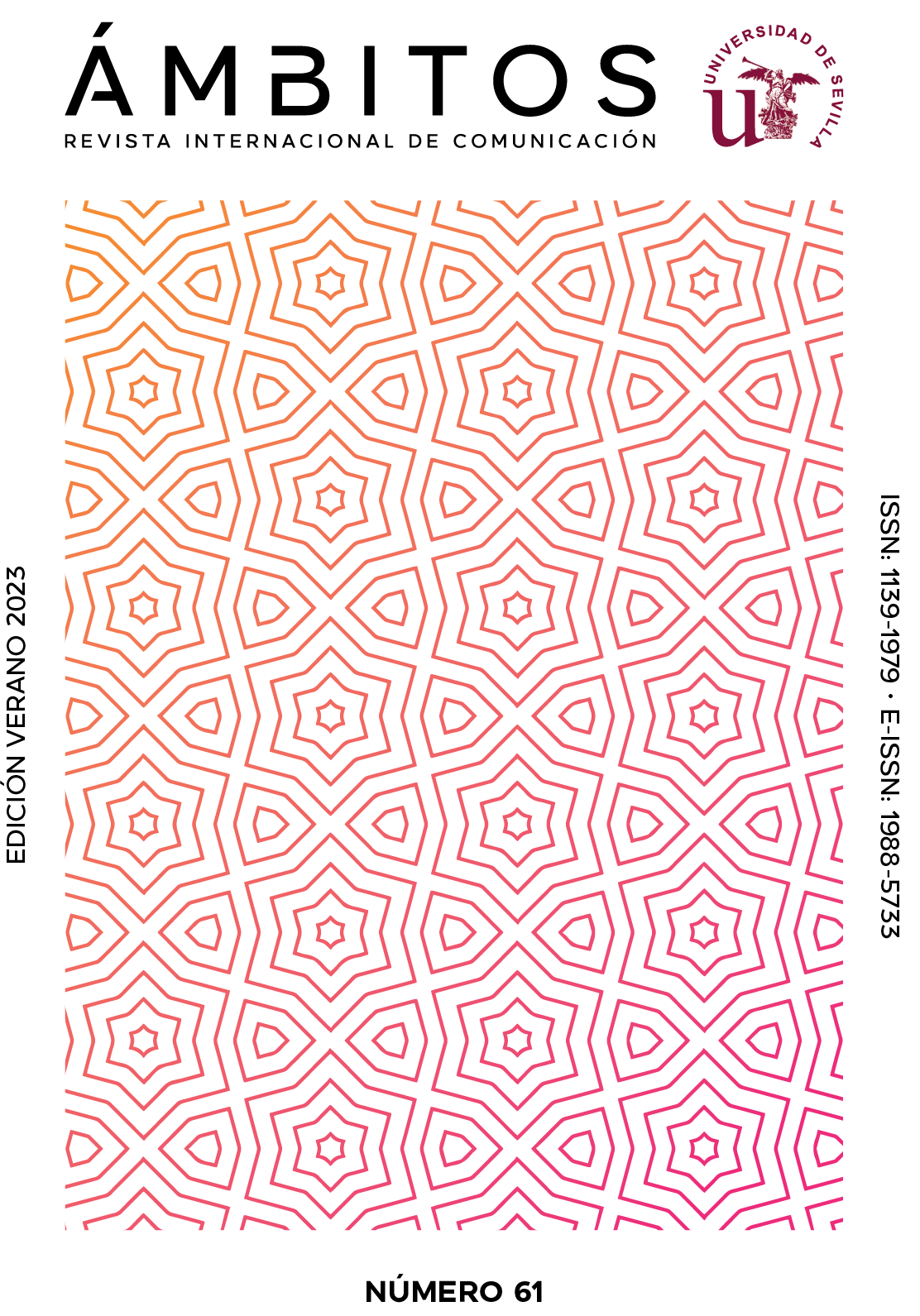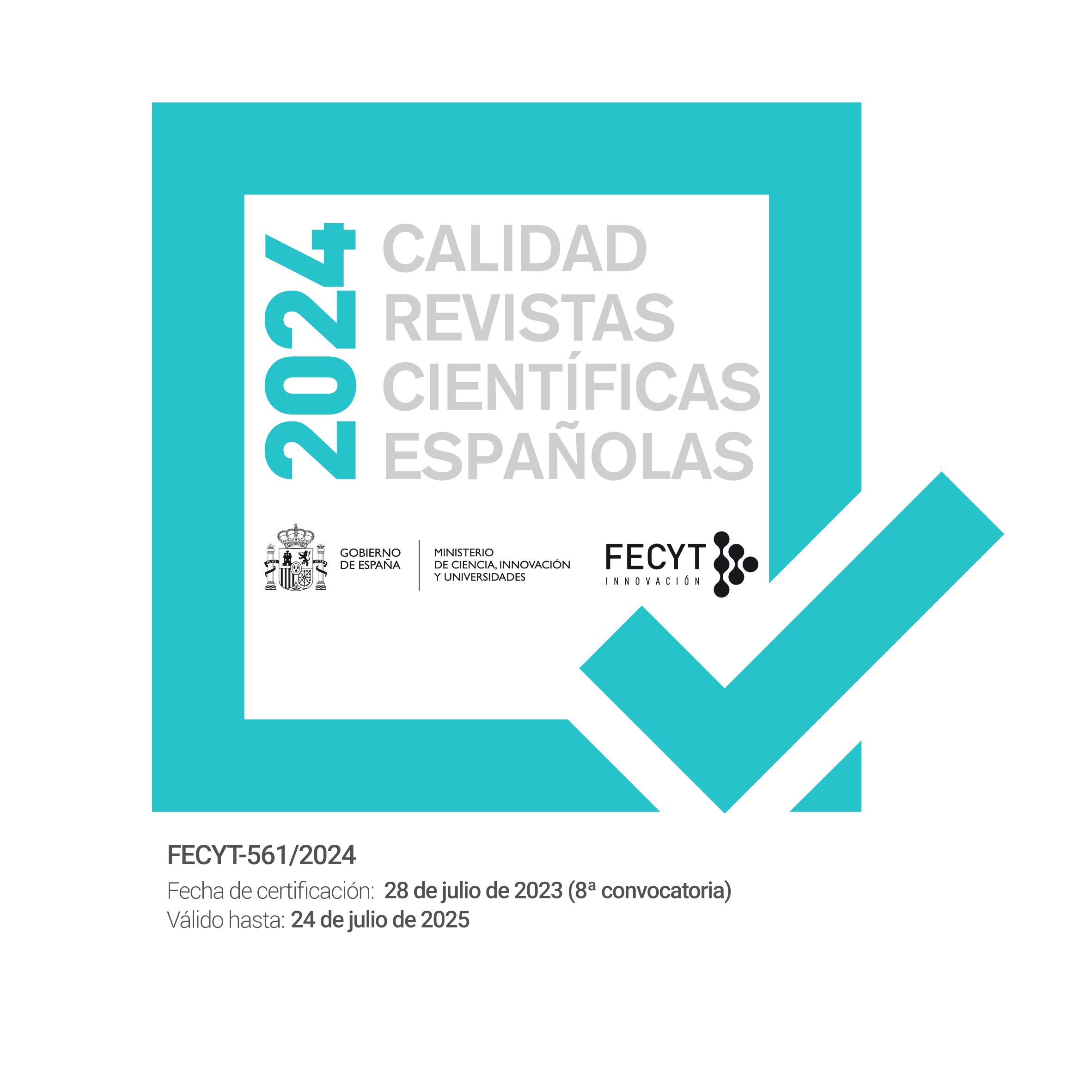La biografía fílmica: una propuesta metodológica para su estudio
DOI:
https://doi.org/10.12795/Ambitos.2023.i61.04Palavras-chave:
Biografía fílmica, biopic, cine, historia, guionResumo
La biografía fílmica, durante muchos años aparejada al cine histórico en cuanto a teorización se refiere, ha empezado a estudiarse paulatinamente como objeto historiográfico autónomo. Su situación fronteriza entre numerosas temáticas narrativas y los desafíos que supone adaptar para el medio audiovisual una vida históricamente documentada suponen un reto para realizadores e investigadores. Dada la limitación temporal del relato, frente a la infinitud de detalles de una vida, los cineastas se enfrentan a una labor de selección, estructuración e interpretación. En la biografía fílmica confluyen el rigor histórico y la necesidad de dramatizar, el mundo real y el mundo narrativo, el particularismo y la universalidad, así como una dialéctica entre el protagonismo del individuo y el de la sociedad. Partiendo de esta compleja hibridación de ámbitos, proponemos establecer una posible metodología de análisis, atendiendo a sus puntos problemáticos bajo diferentes paradigmas de interpretación. Uno, situando el foco en la fama del personaje; el otro, en la idea de felicidad. Así, disertaremos acerca de la conveniencia de que los cineastas emitan o no un juicio sobre el personaje, si existe una verdad histórica y otra narrativa o no hay dualidad posible, la distorsión lícita e ilícita de esa verdad histórica como necesidad para el drama, cómo abordar el denominado tema de la película y cómo el concepto de felicidad permea todo relato biográfico.
Downloads
Referências
Altman, R. (2000). Los géneros cinematográficos. Paidós.
Anderson, C. (1988). Biographical film. En W. D. Gehring (Ed.), Handbook of American Film Genres (pp 331–352). Greenwood.
Aristóteles. (2017). Poética. Editorial Gredos.
Arlanch, F. (2007). La struttura drammatica del biopic. Comunicazioni Sociali, 29(1), 68–104.
Arlanch, F. (2008). Vite da film. Il film biografico nel cinema di Hollywood e nella televisione italiana. Franco Angeli.
Baccanti, A. (2023). Screening the Creative Process. Genius, Gender, and the Contemporary Biopic. Brill. https://doi.org/10.30965/9783846767740
Bingham, D. (2010). Citizen Kane and the Biopic. En D. Bingham (Ed.), Whose lives are they anyway? The biopic as contemporary film genre (pp. 50–71). Rutgers University Press.
Bingham, D. (2013). The lives and times of the Biopic. En R. A. Rosenstone & C. Parvulesco (Eds.), A companion to the historical film (pp. 233–254). Wiley‑Blackwell. https://doi.org/10.1002/9781118322673.ch12
Bowie, M. (2004). Freud and the Art of Biography. En P. France & W. St. Clair (Eds), Mapping Lives: The Uses of Biography (pp. 176–192). Oxford University Press. https://doi.org/10.5871/bacad/9780197263181.003.0011
Burgoyne, R. (2008). The Hollywood Historical Film. Blackwell.
Carnes, M. C. (1996). Past Imperfect: History according to the Movies. Cassell.
Custen, G. (1992). Bio/Pics: How Hollywood constructed public History. Rutgers University Press.
Custen, G. (2000). The Mechanical Life in the Age of Human Reproduction: American Biopics, 1961‑1980. Biography, 23(1), 127–159. https://doi.org/10.1353/bio.1999.0010
Dillon, A. (2021). Biopic, memoria y nostalgia: la biografía del criminal. Ética & Cine, 11(2), 35–45. https://doi.org/10.31056/2250.5415.v11.n2.34184
Eco, U. (1996). Seis paseos por los bosques narrativos. Lumen.
Edel, L. (1979). The Figure under the Carpet. En M. Pachter (Ed.), Telling Lives: The Biographer’s Art (pp. 16–34). New Republic Books.
Ferro, M. (1980). Cine e Historia. Gustavo Gili.
Ferro, M. (1995). Historia contemporánea y cine. Ariel.
Fumagalli, A. (2008). Prefazione. En F. Arlanch, Vite da film. Il film biografico nel cinema di Hollywood e nella televisione italiana (pp. 9–13). Franco Angeli.
Fumagalli, A. (2019). Tra realtà e racconto: La messa in forma di una vita nel cinema hollywoodiano e nella fiction italiana. Comunicazione Sociali, 41(2), 303–317.
Hamilton, N. (2012). How to do a Biography: a primer. Harvard University Press. https://doi.org/10.4159/9780674038219
Landy, M. (1991). British genres. Cinema and society: 1930–1960. Princeton University Press. https://doi.org/10.1515/9781400862184
Labrada, M. A. (1992). Sobre la razón poética. EUNSA.
Magaldi Fernández, A. (2023). Entre la historia y la ficción. La Transición española a través de los biopics históricos. Área Abierta. Revista de comunicación audiovisual y publicitaria, 23(1), 55‑68. https://doi.org/10.5209/arab.86177
Martínez Gil, F. (2013). La Historia y el cine, ¿unas amistades peligrosas? Vínculos de Historia, (2), 351–372.
Moulin, J. (2016). Biophoty: The biofilm in biography theory. Revue LISA, XIV(2). Advance online publication.
Nichols, B. (1997). La representación de la realidad. Paidós.
Pérez Bowie, J. A. (2008). Leer el cine: La teoría literaria en la teoría cinematográfica. Universidad de Salamanca.
Pesce, A. (2008). Storia del cinema biografico in cento film. Le Mani.
Richards, J. (1984). The Age of the Dream Palace: Cinema and Society in Britain 1930‑1939. Routledge & Kegan Paul. https://doi.org/10.5040/9780755697823
Rosenstone, R. A. (1995). Visions of the past: the challenge of film to our idea of History. Harvard University Press.
Rosenstone, R. A. (2007). In praise of the Biopic. En R. V. Francaviglia & J. Rodnitzky (Eds.), Lights, camera, History: Portraying the past in Film (pp. 11–52). A&M University Press.
Rosenstone, R. A. (2014). La película histórica como campo, como modo de pensamiento (historiar) y un montón de malas jugadas que les hacemos a los muertos. En A. L. Hueso y G. Camarero (Eds.), Hacer Historia con imágenes (pp. 19–30). Síntesis.
Salmi, H. (1995). Film as Historical Narrative. Filmhistoria, 5(1), 45–54.
Sanfilippo, M. (2004). Historic Park. La storia e il cinema. Elleu.
Sánchez Noriega, J. L. (2002). Historia del cine. Teoría y géneros cinematográficos, fotografía y televisión. Alianza Editorial.
Sorlin, P. (1974). Clio à l’écran, ou l’historien dans ne noir. Revue d’Histoire Moderne et Contemporaine, 21(2), 252–278. https://doi.org/10.3406/rhmc.1974.2296
Vidal, B. (2014). The biopic and its critical contexts. En T. Brown y B. Vidal (Eds.), The Biopic in Contemporary Film Culture (pp. 1–32). Routledge.
Downloads
Publicado
Como Citar
Edição
Seção
Licença
Copyright (c) 2023 Pablo Úrbez Fernández

Este trabalho está licenciado sob uma licença Creative Commons Attribution-NonCommercial-ShareAlike 4.0 International License.
Ámbitos. Revista Internacional de Comunicación é um jornal de acesso aberto, o que significa que todo o conteúdo está disponível gratuitamente para o usuário ou sua instituição. Os usuários podem ler, baixar, copiar, distribuir, distribuir, imprimir, pesquisar ou vincular ao texto completo dos artigos, ou utilizá-los para qualquer outra finalidade lícita, sem solicitar permissão prévia da editora ou do autor. Esta definição de acesso aberto está de acordo com a Iniciativa de Acesso Aberto de Budapeste (BOAI).

A menos que seja observado o contrário, todo o conteúdo da edição eletrônica é distribuído sob uma "Licença Internacional Creative Commons Attribution-NonCommercial-ShareAlike 4.0". Você pode consultar a versão informativa e o texto legal da licença aqui. Isto deve ser expressamente declarado desta forma, quando necessário.
No caso de aceitação do manuscrito, os autores cedem os direitos da obra para sua publicação à Ámbitos. Revista Internacional de Comunicación sob o contrato de licença Attribution-NonCommercial-ShareAlike 4.0 International (CC BY-NC-SA 4.0). Os autores retêm os direitos autorais e terceiros estão autorizados a copiar, distribuir e fazer uso da obra, desde que cumpram os termos e condições estabelecidos na licença
- Cite a autoria e a fonte original de publicação (revista, editora e URL da obra).
- Não utilizá-los para fins comerciais.
- Se você remixar, transformar ou criar a partir do material, você deve liberar suas contribuições sob a mesma licença que o original.
Mais informações podem ser encontradas em
https://creativecommons.org/licenses/by-nc-sa/4.0/deed.es


















